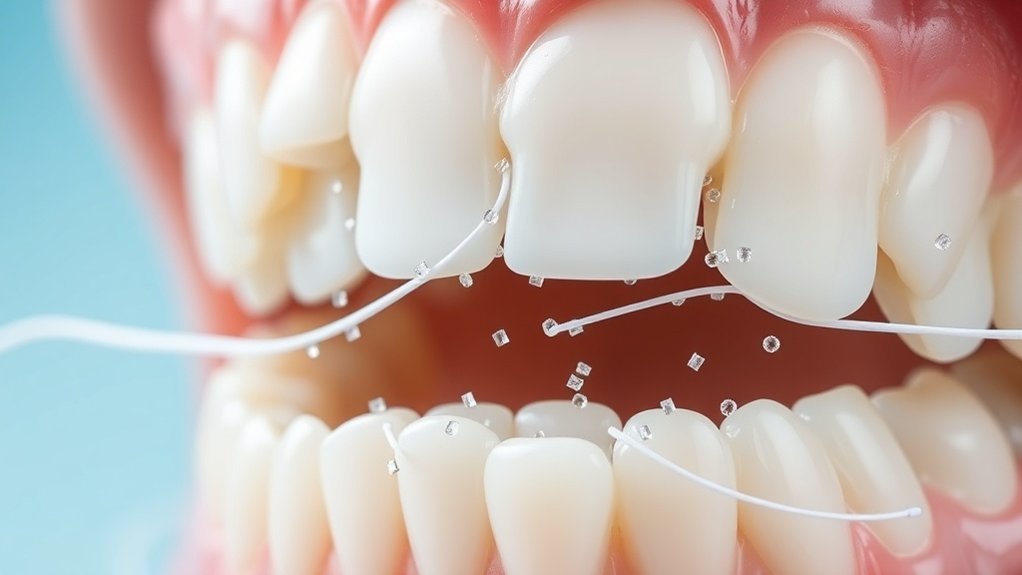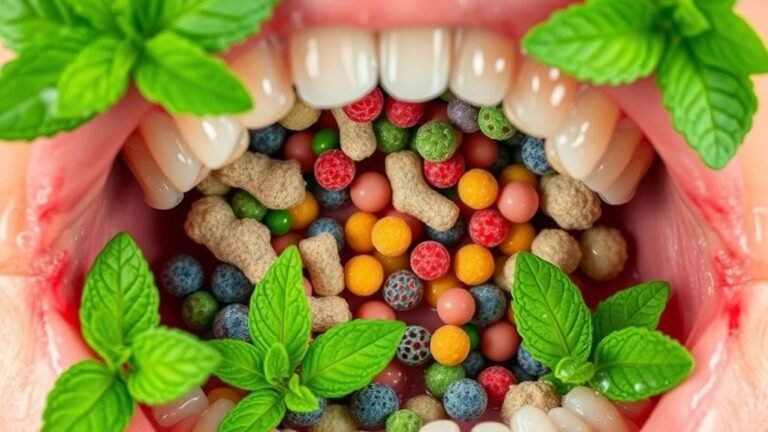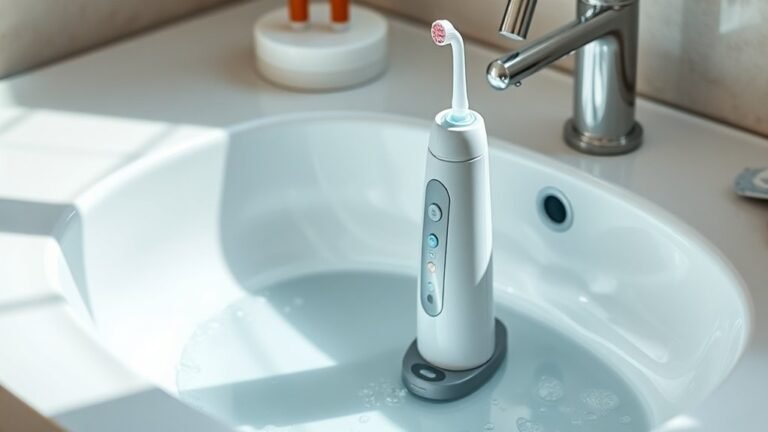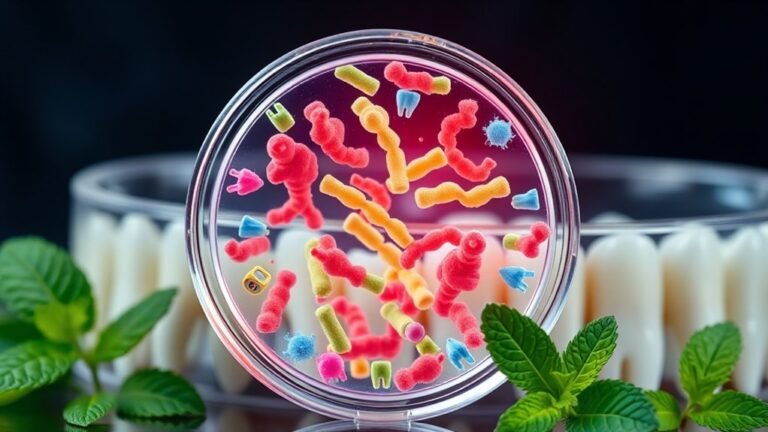Flossing Every Day Prevents Plaque From Turning Into Hard Tartar Deposits
Flossing every day is essential for preventing plaque from hardening into hard tartar deposits. Plaque builds up on your teeth continuously, and if not removed, it can calcify into tartar, which can only be removed by a dental professional. By flossing daily, you can effectively remove plaque and food particles between your teeth, greatly lowering the risk of gum disease, cavities, and bad breath. Discover how to establish a consistent flossing habit for better oral health.
Key Takeaways
- Daily flossing removes plaque and food particles between teeth, preventing buildup that leads to tartar formation.
- Flossing reaches areas that toothbrushes can’t, enhancing overall plaque removal and gum health.
- Regular flossing reduces the risk of gum disease, which is exacerbated by tartar accumulation.
- Establishing a consistent flossing routine helps maintain healthy gums and prevents plaque from hardening.
- Healthy gums and reduced plaque buildup contribute to overall dental health and a confident smile.
Understanding Plaque and Tartar Formation
While you may not see it, plaque is constantly forming on your teeth. This soft, sticky film contains bacteria that feed on sugars in your mouth, leading to plaque buildup. If you don’t remove plaque through regular brushing and flossing, it can harden into tartar, which is much more difficult to eliminate. Tartar removal often requires professional dental cleaning, as it can’t be removed with a toothbrush alone. Left untreated, tartar can contribute to gum disease and tooth decay. To maintain ideal oral health, it’s important to stay proactive. Incorporating daily flossing into your routine not only helps prevent plaque buildup but also aids in keeping tartar at bay, ensuring a healthier mouth and brighter smile.
The Role of Flossing in Oral Hygiene
Flossing plays an essential role in your oral hygiene routine by removing plaque and food particles from between your teeth where your toothbrush can’t reach. Understanding proper flossing techniques and its importance can enhance your overall dental health considerably. Let’s explore how daily flossing compares to tooth brushing and why it deserves a spot in your daily regimen.
Importance of Daily Flossing
Many people underestimate the importance of daily flossing in maintaining ideal oral hygiene. Flossing plays a critical role in plaque prevention by removing food particles and debris between teeth where your toothbrush can’t reach. By incorporating daily flossing into your routine, you greatly reduce the risk of gum disease and cavities.
Here’s a quick overview of the benefits of daily flossing:
| Benefits | Description | Impact on Oral Health |
|---|---|---|
| Plaque Removal | Eliminates plaque buildup between teeth | Reduces cavity risk |
| Gum Health | Promotes healthy gums | Prevents gum disease |
| Fresh Breath | Removes odor-causing particles | Enhances breath quality |
| Overall Health | Links oral health to overall wellness | Improves overall health |
| Easy to Incorporate | Quick addition to daily routine | Encourages consistency |
Flossing Techniques Explained
Understanding the various flossing techniques can greatly enhance your oral hygiene routine. Effective plaque removal requires proper methods, ensuring that you clean between your teeth thoroughly. Here are four essential flossing techniques to contemplate:
- The Loop Technique: Create a loop with the floss, securing it around your fingers for better control.
- The C-Shape Method: Curve the floss around each tooth in a C-shape, ensuring you reach the gum line.
- The Ribbon Method: Use a wider piece of floss for larger gaps, allowing for more surface area contact.
- Floss holders: Think about using a floss holder or pick for easier access, especially in hard-to-reach areas.
Incorporating these flossing techniques will greatly improve your plaque removal efforts and contribute to better oral hygiene.
Flossing vs. Toothbrushing
When it comes to maintaining ideal oral hygiene, both flossing and toothbrushing play essential roles, but they serve distinct purposes. Toothbrushing effectively removes surface debris and reduces dental plaque on the outer surfaces of your teeth. However, it can’t reach the tight spaces between your teeth where plaque often accumulates. This is where flossing becomes vital. By sliding dental floss between your teeth, you remove plaque and food particles that brushing might miss. Doing both daily guarantees thorough cleaning, preventing plaque from hardening into tartar, which can lead to gum disease and cavities. So, don’t underestimate the importance of flossing; it complements your brushing routine and enhances your overall oral health. Prioritize both for a healthier smile.
How Plaque Becomes Tartar
When you neglect to floss, plaque begins to accumulate on your teeth and gums. This soft, sticky film can harden into tartar within just a few days if not removed. Understanding the formation process of plaque and the timeline for tartar development is essential for maintaining your oral health.
Plaque Formation Process
Although you may not notice it immediately, plaque begins forming on your teeth shortly after eating. This sticky film of bacteria can lead to dental plaque buildup if not managed through proper plaque control. Here’s how plaque forms:
- Food Residue: Bits of food left on your teeth provide a breeding ground for bacteria.
- Bacterial Colonization: These bacteria multiply, forming a soft, sticky layer on your enamel.
- Mineralization: Over time, minerals from your saliva combine with the bacteria, hardening the plaque.
- Tartar Formation: If plaque isn’t removed, it turns into tartar, which can only be removed by a dental professional.
Understanding this process highlights the importance of daily oral hygiene in preventing plaque buildup and maintaining dental health.
Tartar Development Timeline
As plaque remains on your teeth without proper cleaning, it undergoes a transformation that leads to tartar development. This process typically takes about 24 to 72 hours. Initially, bacterial plaque accumulates, forming a soft layer. If not removed, minerals from saliva begin to harden this layer into tartar deposits.
| Time Frame | Stage | Description |
|---|---|---|
| 0-24 hours | Plaque Formation | Bacterial plaque builds up |
| 24-72 hours | Early Tartar Formation | Minerals crystallize |
| 72+ hours | Hard Tartar Deposits | Tartar forms, hardening |
Understanding this timeline emphasizes the importance of daily flossing to prevent tartar buildup and maintain oral health.
Consequences of Neglecting Flossing
Neglecting to floss daily can lead to a range of oral health issues, which may surprise you. Without proper flossing, you risk:
- Gum Disease: Accumulated plaque can irritate your gums, leading to gingivitis and more severe periodontal disease, jeopardizing gum health.
- Increased Oral Bacteria: Flossing removes food particles and plaque that harbor oral bacteria, preventing their overgrowth.
- Cavities: Missed areas between your teeth can develop cavities, which may require fillings or more invasive treatments.
- Bad Breath: Trapped food and bacteria can lead to persistent bad breath, affecting your confidence and social interactions.
Proper Flossing Techniques
Mastering the right flossing techniques can greatly enhance your oral hygiene routine. To effectively incorporate flossing into your daily habits, follow these steps:
| Step | Description |
|---|---|
| 1. Select Your Floss | Choose waxed or unwaxed, depending on your preference. |
| 2. Use Enough Length | Cut about 18 inches of floss for easy handling. |
| 3. Proper Grip | Wrap the ends around your fingers for control. |
| 4. Correct Technique | Gently slide the floss between teeth, curving it around each tooth. |
| 5. Rinse | Finish with a mouthwash to enhance your oral care routine. |
Benefits of Daily Flossing
Daily flossing offers numerous advantages for your oral health, ensuring you maintain a bright smile and prevent dental issues. Here are some key benefits:
- Enhanced Oral Hygiene: Flossing removes food particles and plaque between teeth that brushing alone can miss.
- Cavity Prevention: By eliminating plaque buildup, you greatly reduce the risk of cavities forming in hard-to-reach areas.
- Fresh Breath: Regular flossing helps remove bacteria that cause bad breath, leaving your mouth feeling fresh.
- Cost-Effective: Investing a few minutes daily in flossing can save you from costly dental treatments down the line.
Incorporating flossing into your daily routine is essential for maintaining ideal oral hygiene and ensuring long-term dental health.
Flossing and Gum Health
Flossing plays an important role in maintaining healthy gums, as it effectively removes plaque and food debris from areas that toothbrushes often miss. When you floss daily, you help prevent gum inflammation, a key factor in gum disease. Ignoring the spaces between your teeth can lead to plaque buildup, which can result in swollen, red gums and even gum bleeding. By incorporating flossing into your routine, you greatly reduce the risk of these issues, promoting better gum health. Consistent flossing not only keeps your gums free from harmful bacteria but also contributes to fresher breath and a healthier mouth overall. Remember, healthy gums are essential for a confident smile and overall oral health, so don’t underestimate the power of flossing.
Tips for Making Flossing a Daily Habit
Incorporating flossing into your daily routine can markedly enhance your gum health and overall oral hygiene. Here are some tips to help you make flossing a consistent habit:
- Set a specific time: Choose a time that works best for you, whether it’s morning or night, and stick to it.
- Use the right tools: Find a floss or flosser that feels comfortable and easy to use, ensuring you’ll stick with it.
- Pair it with another habit: Link flossing to another daily activity, like brushing your teeth, to create a routine.
- Track your progress: Keep a journal or use an app to monitor your flossing frequency, encouraging consistency for a healthier oral microbiome.
With these strategies, you’ll find flossing becomes second nature.
Frequently Asked Questions
Can Children Floss, and at What Age Should They Start?
Yes, children can start flossing around age two or three, once they have two teeth touching. Supervise them until about age eight to guarantee they’re doing it correctly and effectively.
What Type of Dental Floss Is Best for Sensitive Gums?
For sensitive gums, choose a waxed dental floss or a soft, gentle floss designed for comfort. These options glide more easily between teeth, minimizing discomfort while effectively removing plaque and food particles without causing irritation.
How Often Should I Replace My Dental Floss?
You should replace your dental floss every few months or sooner if it frays. Just like a knight needs a sharp sword, you need effective floss to keep your gums healthy and free from plaque.
Is It Necessary to Floss if I Brush Twice Daily?
Yes, it’s necessary to floss even if you brush twice daily. Brushing alone can’t reach between your teeth effectively, where plaque accumulates. Flossing guarantees a thorough clean, promoting better oral health and preventing gum disease.
Can Flossing Too Aggressively Cause Gum Damage?
Oh sure, go ahead and wrestle with your floss! But seriously, flossing too aggressively can definitely damage your gums. Gentle, consistent flossing keeps your mouth healthy without turning it into a wrestling match.
Conclusion
Incorporating daily flossing into your oral hygiene routine can greatly reduce plaque buildup, preventing it from hardening into tartar. Research shows that individuals who floss regularly can remove up to 40% more plaque than those who skip it. By committing to this simple yet effective practice, you not only protect your teeth but also promote healthier gums. Remember, maintaining your oral health is an investment in your overall well-being, so make flossing a non-negotiable part of your day.






